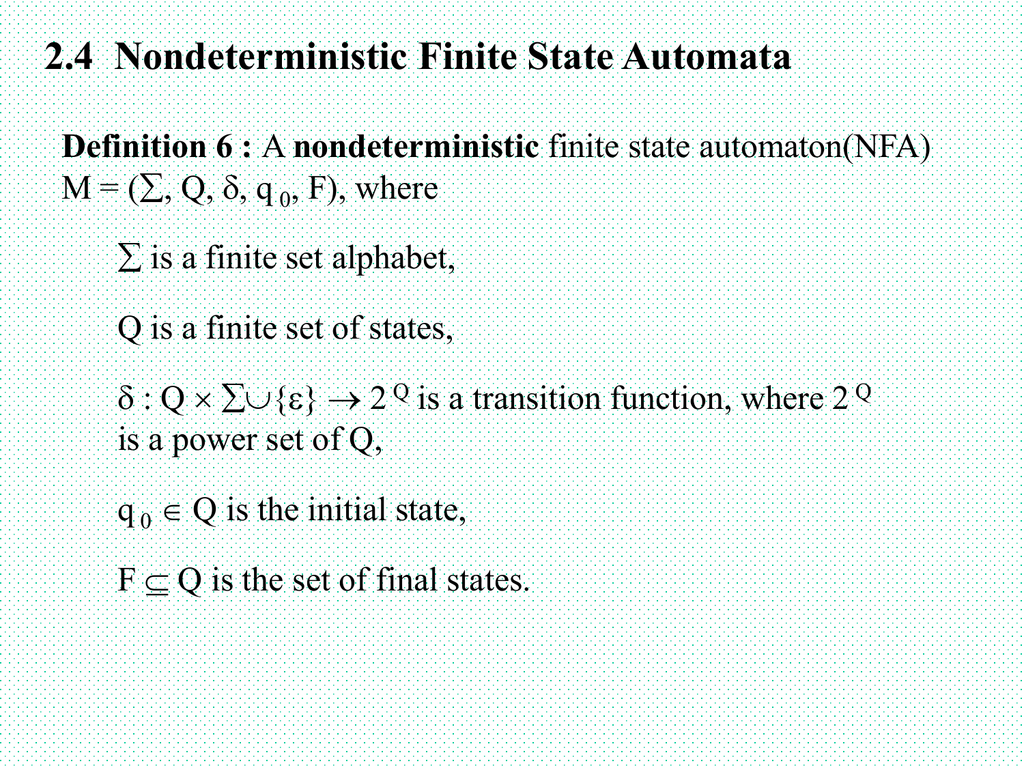
I wanted a decorator-based state machine without having to use Django.
#FIZZI TO DRAW FINITE STATE AUTOMATA INSTALL#
To install a package locally for development, run: flit install Running Tests pytest Inspiration Set up pre-commit hooks in repo: pre-commit install.$ fsm_draw_state_diagram -class examples.turnstile:Turnstile -initial_state close $ fsm_draw_state_diagram -class examples.turnstile:Turnstile Use the fsm_draw_state_diagram command and point to State Machine workflows can be visualized using aįinite-state-machine generates diagrams using The examples folder contains additional workflows. _init_ () ( source =, target = "open" ) def insert_coin ( self ): pass ( source = "open", target = "close" ) def pass_thru ( self ): pass REPL In : turnstile = Turnstile() In : turnstile.state Out: 'close' In : turnstile.insert_coin() In : turnstile.state Out: 'open' In : turnstile.insert_coin() In : turnstile.state Out: 'open' In : turnstile.pass_thru() In : turnstile.state Out: 'close' In : turnstile.pass_thru() - InvalidStartState Traceback (most recent call last) in -> 1 turnstile.pass_thru() ~/state_machine.py in _wrapper(*args, **kwargs) 32 33 if self.state not in source: -> 34 raise InvalidStartState 35 36 for condition in conditions: InvalidStartState: Where the transition function raises an exception: ( source = "off", target = "on", on_error = "failed" ) def turn_on ( self ): raise ValueError Example from finite_state_machine import StateMachine, transition class Turnstile ( StateMachine ): initial_state = "close" def _init_ ( self ): self. state = "off"Ĭan also specify an on_error parameter to handle situations ( source = "off", target = "on", conditions = ) def turn_on ( self ): # specify side effects def light_is_off ( machine ): return machine. Choice 2: one-hot encoding For N states, use N bits to encode the state where the bit corresponding to the current state is 1, all the others 0. Tradeoffs: most efficient use of state registers, but requires more complicated combinational logic to detect when in a particular state. Keyword arguments present in the transition function. state represented by a unique combination of the bits. The following figure shows some essential features of general automation. Basically, it is an abstract model of a digital computer. It has a set of states and rules for moving from one state to another but it depends upon the applied input symbol. States can be of type: string, int, bool, Enum, or IntEnum.Ĭan specify a single sate or a list of states for the source parameter Ĭan only specify a single state as the target target.Īll condition functions need to return True for the transition to occur,Įlse a ConditionsNotMet exception will be raised.Ĭondition functions require the same positional position and The finite automata or finite state machine is an abstract machine that has five elements or tuples. With an optional parameter for conditions. The transition decorator can be used to specify valid state transitions Subclass StateMachine and set the state instance variable: from finite_state_machine import StateMachine, transition class LightSwitch ( StateMachine ): def _init_ ( self ): self. Installation pip install finite-state-machine Usage The above figure ( Figure 3.4) indicates that in state q when the machine gets input i, it goes to state p and outputs o.Lightweight, decorator-based Python implementation of a Finite State Machine.


The transition from one state to another is represented by directed edge. When considered as recognition devices, the final states are represented as double circles. The only difference is how the transition function is specified.

There is a generalization called a non-deterministic finite-state automaton or NFA. The initial state is marked with an arrow pointing to it. The finite state automata we have seen so far are often called deterministic finite-state automata or DFAs. They are represented as circles with labels written inside them. Choose such a string with k n which is greater than m. Since M recognizes the language L all strings of the form a kb must end up in accepting states. An Intro to the inner-workings of Compilers, Programming Languages, and Machines. The figures we have seen are called the state diagrams. by a Finite State Automata Since M is a finite state automata it has a finite number of states. Formal Languages & Finite State Automata: From the Beginning. So, it is seen that the output depends both on the input and the state. At time t = 4, 5, the input is 00, but the output is 1 at time t = 4 and 0 at t = 5. It should be noted that at time t = 1, 3, 6, the input is 11, but the output is 0 at t = 1, 6 and is 1 at time t = 3. At time t = 7, no input is there (and this is taken as 00) and the output is 1. At time t = 6, the input is 11 the machine outputs 0 and goes to ‘carry’ state.

At time t = 5, the input is 00 the output is 0 and the machine remains in ‘no carry’ state. At time t = 4, the input is 00 the machine outputs 1 and goes to ‘no carry’ state. At time t = 3, it gets 11 and outputs 1 and remains in ‘carry’ state. Here at time t = 2, the input is 01 the output is 0 and the machine remains in ‘carry’ state. The input at time t = 1 is 11 and the output is 0, and the machine goes to ‘carry’ state.


 0 kommentar(er)
0 kommentar(er)
